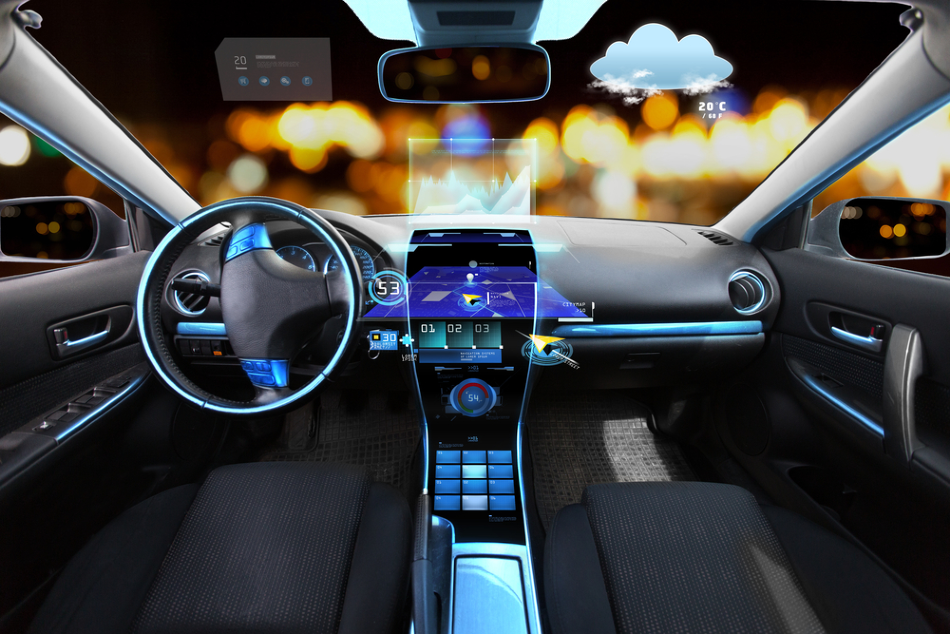
Image Credit: Syda Productions/Shutterstock.com
What is it that defines a car as being smart? Intelligent vehicles house a range of technologies that will eventually converge to deliver the goal of the autonomous vehicle or what we call “the driverless car”. Many of these technologies are discrete and have been gradually appearing in cars over the last 30 years.
The earliest sensors in vehicles started a trend that continues into current automotive design, aiding the driver and removing some of the responsibility for decision making. These sensors monitor oil pressure, battery charging, and temperature. They are relatively simple circuits that illuminate a dashboard light to indicate a problem and more of them found their way into cars, monitoring brake pad wear, seat belt use, and tire pressure.
These sensors help the driver to monitor the condition of their vehicle and indicate when manual intervention is required. They also alert the driver to possible vehicle damage. Basic computer modules began appearing in cars in the mid-80s when manufacturers such as Porsche, Mercedes-Benz, and Datsun started installing electronic control modules (ECM) to monitor engine, fuel, and emission performance. This was largely in response to U.S. EPA emissions standards requiring the use of catalytic converters.
Innovative Smart Features in Modern Cars
When a computer is installed in a vehicle, it can be used to monitor many functions and inputs from any number of sensors. Most modern vehicles will have lights that automatically switch on in darkness and windscreen wipers triggered by a sensor that detects rain on the windscreen. Proximity sensors that detect objects are used to aid parking. Basic systems that beep when close to an object have been replaced by front and rear cameras that provide additional information.
Automated Parking Technologies Using Mapping and Lasers
In 2006, Lexus was first to the market with an automated parking feature that astounded visitors when the self-parking LS 460 sedan appeared at the Detroit International Auto Show. The Advanced Parking Guidance System (APGS) used sonar sensors on the bumpers to measure the length of the space and distance from the cars.
The technology has advanced to the BMW i3 concept car that searches for a parking space on its own using voice commands via a smartwatch. It uses mapping and lasers to guide the car, even in a parking garage.
Sensors Technology for Collision Mitigation
Sensor technology has enabled vehicle manufacturers to use these current systems working together to develop collision mitigation systems. These incorporate active braking that can slow the car when approaching standing traffic. Lane departure systems have also been developed to monitor lines on the road, warning the driver if the car wanders or even nudging it back on track.
Google’s experimental autonomous vehicle “Google car” uses eight sensors to gather information on its environment. The most visible being the LIDAR camera mounted on its roof that uses several lasers to check for hazards 200 m around the car. It receives some information regarding its location via GPS, though that alone is not accurate enough.
All of these technologies contribute vehicle safety on increasingly busy roads, though there are concerns that drivers could become complacent in cars that still need a vigilant human in control. However, to be truly autonomous, a vehicle has to be aware of its environment, be able to interact with other vehicles and be safe around the most unpredictable pedestrians.
What Does the Future Hold for Driverless Cars?
GPS does not offer all of the information needed for safe driverless operation. For autonomous vehicles to function, a connected car infrastructure is required, meaning even cars driven by a human would need to carry the technology that could exactly pinpoint the location of a vehicle and share it with others in an area.
In Europe, German carmakers have made a significant commitment to connected car infrastructures. In 2018, Daimler, BMW, and Audi paid $3.1 billion for the Nokia Here mapping service, which they plan to use as a platform for a connected-car environment.
Vehicle telematics has been developed iteratively to make autonomous vehicles on our roads a reality. But despite the enormous amount of research and investment, there are still many issues to resolve.
Human drivers are constantly making adjustments and predictions about the behavior of other drivers and evaluating scenarios that unfold on everyday journeys, and they can be held to account for those decisions. Until there is a “connected car infrastructure” and software that evaluates and makes decisions about vehicle behavior in thousands of different circumstances, it is difficult to imagine being able to trust the technology and the ethical issues that it raises.
While the individual technologies continue to evolve to make roads safer, more efficient, and less of an ecological burden, even our current “smartest” car is not quite as clever as it needs to be.
References and Further Reading
Disclaimer: The views expressed here are those of the author expressed in their private capacity and do not necessarily represent the views of AZoM.com Limited T/A AZoNetwork the owner and operator of this website. This disclaimer forms part of the Terms and conditions of use of this website.